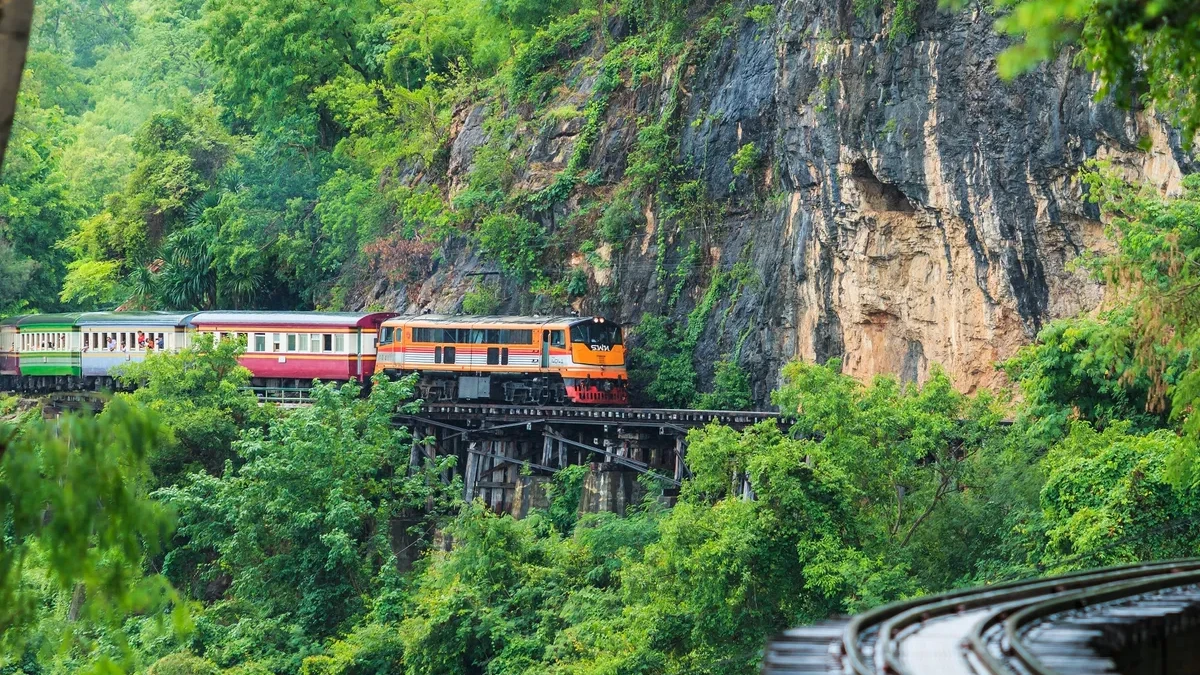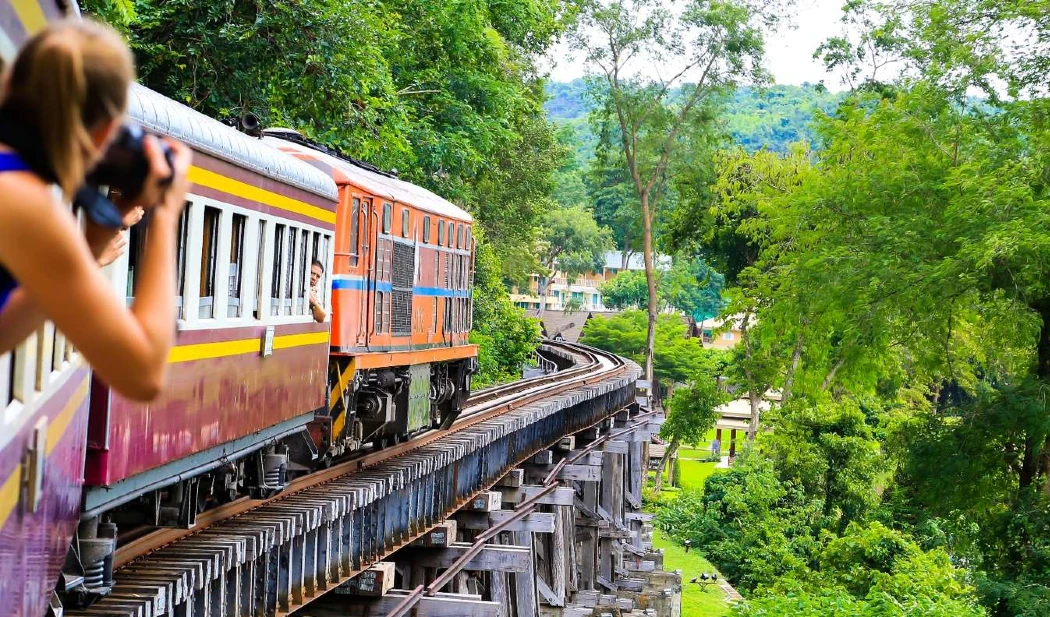
The “Death Railway” is the surviving Thai section of the WWII Burma–Thailand Railway, a 130-km line that today runs from Nong Pla Duk Junction to Nam Tok in Kanchanaburi Province.
Built in 1942–43 by Allied prisoners of war and Asian laborers under Japan’s army, it cost more than 100,000 lives and has since become one of Southeast Asia’s most poignant heritage journeys.
It is a living railway you can still ride across the famous Bridge over the River Kwai and along the cliff-hugging wooden trestles at Tham Krasae (Wang Pho).
Kanchanaburi Province welcomes around 5 million visitors each year, and riding the Death Railway—paired with its museums and memorials—is a principal reason many come.
This guide covers everything you need to know before you buy a ticket or plan a day trip, from the best tours, how and where to get train tickets, to the best times, routes, add-on sites (Hellfire Pass, waterfalls), etc.
Table of Contents
Where to buy tickets?
Short answer: at the station, on the day, for the regular trains.
The Death Railway is operated by the State Railway of Thailand (SRT) as ordinary commuter services (train numbers 257/259 outbound; 258/260 inbound).
For these local trains, SRT sells tickets only on the day of travel at the station counter. Arrive 30–45 minutes early to buy and board.
Start at Bangkok’s Thon Buri Station for the full run to Kanchanaburi and onward to Nam Tok. For shorter scenic segments, board at Kanchanaburi, River Kwai Bridge (Saphan Kwae Yai), Tham Krasae (Wang Pho), or Nam Tok stations.
On weekends and holidays, SRT operates special day-trip excursion trains from Bangkok with extended sightseeing stops. These often sell out in advance.
If you want hotel pickup, guaranteed seats together, or a packed day combining waterfalls, museums, and the train ride, consider a guided Death Railway tour instead.
Best Death Railway tours
Here are two of the most popular tours from Bangkok, which include the Death Railway experience.
From Bangkok: Death Railway & Hellfire Pass Tour with Lunch
On this tour from Bangkok to Kanchanaburi, after travelling 3.5 hours by van, you reach the Hellfire Pass Memorial Museum.
In 90 minutes, you explore the Interactive Center and learn about the “dramatic section of the railway that the PoWs cut through a mountain”. Thereafter, you go on a quick walking trail.
You will then go on a 45-minute train ride along the historic Death Railway and also make a 20-minute visit to the Bridge Over the River Kwai, an iconic symbol of the builders’ struggles.
You will also visit the Railway Museum, Kanchanaburi (also referred to as the Thailand-Burma Railway Museum) and the Kanchanaburi War Cemetery.
- Transportation: Hotel pickup and drop-off
- Guide: An English-speaking tour guide
- Meals: Lunch at a local restaurant
- Price: ฿2,500 per person
Kanchanaburi, River Kwai & Death Railway Tour
This is a 10-hour private day tour from Bangkok, designed to help tourists soak up Thailand’s history and experience Death Valley and nearby attractions.
The tour begins with a visit to the Kanchanaburi War Cemetery, where you honor the fallen prisoners of war (POWs) and civilians who died while working on the infamous Death Railway.
Next, visit the JEATH War Museum for historical context, then make a brief stop at the iconic Bridge over the River Kwai—synonymous with the Death Railway’s history—before continuing to Tham Krasae Station.
The day concludes with an exploration of Wat Tham Suea (Tiger Cave Temple), involving a steep hike to see its large, gleaming 18-meter-tall Buddha statue and enjoy impressive scenery.
- Transportation: Hotel pickup and drop-off
- Guide: An English-speaking live tour guide
- Meals: Lunch is included
- Cost: ฿7,137 per group up to 4 people.
Tip: If your priority is just the scenic rail, buy the ordinary train Kanchanaburi → Tham Krasae (Wang Pho) → Nam Tok segment for cliff and river views, then return by road or the next train.
Death Railway timings
It is always best to plan your experience around the first and last daily Death Railway trains on the Kanchanaburi–Nam Tok section:
- Thon Buri (Bangkok) → Kanchanaburi → Nam Tok: typical departures include 07:45 and 13:55 from Thon Buri (arriving Nam Tok around 12:35 and 18:15 respectively).
- Nam Tok → Kanchanaburi → Thon Buri: typical departures 05:20 and ~13:00 (arriving Thon Buri 09:35 and ~17:40).
Always check for updated times before planning.
Best time to experience the Death Railway
If you want to avoid the crowd, it is best to start early on weekdays. Boarding at Thon Buri 07:45 or joining at Kanchanaburi mid-morning typically feels calmer than the mid-afternoon wave.
For the best scenery on the wooden trestles at Tham Krasae/Wang Pho, many travelers aim for the late morning westbound or early afternoon eastbound runs so the river, cave, and cliffs are well-lit.
For the most comfortable temperatures and clearer air, it is best to explore the Railways between November and February.
Important: In late November–early December, Kanchanaburi hosts the “River Kwai Bridge Week” Light & Sound festival—expect bigger crowds but unique evening spectacles.

Where is the attraction & how to reach
To explore the Death Railway, you must visit the Kanchanaburi Province, west of Bangkok.
Getting there from Bangkok
- By train: Board at Thon Buri; buy same-day tickets and ride directly to Kanchanaburi, River Kwai Bridge (Saphan Kwae Yai) Station, Tham Krasae, or Nam Tok.
- By bus/minivan: Frequent departures from Southern Bus Terminal (Sai Tai Mai) to Kanchanaburi (around THB 110–150, ~2.5–3 hours), with onward local transport to the bridge or stations.
- By tour/driver: This is the best option if you want Hellfire Pass and waterfalls plus the rail segment in one day.
What to see during Death Railway experience
Here are some of the attractions you will see while exploring the Death Railway.
The Bridge over the River Kwai (Saphan Kwae Yai)
Kanchanaburi’s iconic steel bridge—you can walk across when no train is passing; step onto the escape platforms when one approaches (trains crawl through at low speed). The bridge is the symbol of the province and a prime photo stop.
Tham Krasae / Wang Pho Viaduct
A 400-meter, cliff-hugging wooden trestle above the Khwae Noi River—the scenic highlight. Get off at Tham Krasae (Saphan Tham Krasae) to walk the boardwalk, visit the small cave shrine, and watch the train creep by inches from the rock face.
Kanchanaburi War Cemetery & Thailand–Burma Railway Centre
The War Cemetery & Thailand–Burma Railway Centre are next to each other in Kanchanaburi.
The Commonwealth cemetery is free to enter, and the Railway Centre museum provides context and names behind the statistics.
JEATH War Museum
JEATH War Museum derives its name from an acronym representing the countries involved in the construction of the Death Railway during World War II. The name stands for Japan, England, Australia, Thailand, and Holland.
It is a modest, older museum, and the entry fee is approximately ~THB 50.
Nam Tok & Sai Yok Noi Waterfall
The rail terminus area is your jumping-off point for Sai Yok Noi Waterfall (the weekend excursion rolls a bit farther to Nam Tok Sai Yok Noi Halt), and for road trips to Hellfire Pass.
What to wear for the Death Railway
There’s no formal dress code for the train ride or bridge, but comfort and safety rule:
- Wear breathable clothing, sun protection, and sturdy shoes for walking the bridge/viaduct boardwalks.
- Avoid dangling scarves or loose items you might lean out with—carriages have open windows and the train passes close to rock faces in places.
- If you enter temples or certain museum spaces, have shoulders/knees covered as a sign of respect (a light shawl or wrap is handy).
Death Railway at night?
The photogenic viaduct at Tham Krasae, which is an integral part of the Death Railway experience, is best (and safest) in daylight. Besides, most trains on the Kanchanaburi–Nam Tok section operate in daylight.
If you’re visiting during River Kwai Bridge Week (late Nov–Dec), night visits are possible. Sound-and-light shows around the bridge area make it a happening event.
Is the Death Railway worth the effort?
Absolutely—few places combine a functioning heritage railway, powerful WWII memory, and tropical river scenery so accessibly.
Crossing the Bridge, rolling along the wooden trestles, and then reflecting in the museums and cemeteries make a day that’s both beautiful and sobering. This experience stays with you long after the train pulls in.
Things to know before you go
- Buy tickets same-day at the station for ordinary trains; lines form near departure time.
- Seat reservations aren’t assigned on 3rd-class; sit where you find space. Vendors sell drinks/snacks onboard.
- Best seats for views: left-hand side heading toward Nam Tok across Tham Krasae; right-hand side toward Bangkok.
- Timetables can change or run late—check for the latest schedules.
- Bridge safety: When a train whistles, step onto the escape platforms and wait; don’t stand on the rails for photos.
- Pairing Hellfire Pass: from Nam Tok, budget 3–4 extra hours by road to visit Hellfire Pass and the shorter memorial trail.
Restaurants near the railway line
- Keeree Tara Restaurant (near the Bridge): Riverside, Bali-style setting about 50 m from the Bridge; popular for sunsets and Thai classics—handy before or after your bridge walk.
- Tham Krasae restaurants/cafés (by the viaduct): Simple Thai eateries with front-row views of the trestles and river—great lunch stop while waiting for the next train to rumble by.
What to see nearby
While you explore the Thai-Burma (Death) Railway, here are some important tourist attractions nearby:
- Hellfire Pass Interpretive Centre & Memorial Walking Trail: The most moving site on the old alignment; combine with the train ride for a full-day remembrance trip.
- Sai Yok Noi & Sai Yok Yai Waterfalls: Cool-off stops near Nam Tok. (Weekend excursion trains continue to Sai Yok Noi Halt.)
- Mon Bridge (Uttamanusorn Bridge), Sangkhlaburi: Thailand’s longest wooden bridge in an atmospheric Mon–Thai town near the Myanmar border (longer side-trip).
Frequently asked questions
Here are some questions tourists ask before booking their tour of the Death Railway.
Do I need to book Death Railway tickets online in advance?
No—ordinary trains sell same-day tickets only at the station. Special weekend/holiday excursion train tickets tend to sell out, so they require advance purchase. If you are booking a Death Railway tour, it’s better to book early.
What’s the difference between the regular train and the excursion train?
Regular trains are point-to-point services with a few long stops. Excursion trains are day trips from Bangkok with scheduled sightseeing stops (bridge, cemetery, waterfalls).
Which side of the train has the best views?
For Tham Krasae/Wang Pho, sit on the left-hand side heading toward Nam Tok.
Can I walk on the Bridge over the River Kwai?
Yes, when no train is crossing, you can walk on the bridge. However, when a train approaches, you must step onto the escape platforms.
Are there toilets on board?
Yes, but they’re basic. Carry tissues/hand gel and expect squat-style restrooms at smaller stations.
Can I visit Hellfire Pass and the Death Railway on the same day?
Yes—ride the morning train to Nam Tok, continue by road to Hellfire Pass, then return to town or Bangkok by car/tour. Allow 3–4 hours for the pass itself. If you plan to combine Hellfire Pass with the Death Railway, it is best to book a tour.
In Summary
- Buy at the station, same day for regular trains; aim for the 07:45 from Thon Buri or midday segments around the bridge/viaduct for great light and fewer crowds.
- The Bridge and Tham Krasae/Wang Pho Viaduct are the scenic and emotional highlights. It is best to pair them with the Railway Centre museum for context.
- For a seamless day (train + Hellfire Pass + waterfall), book a guided tour or private driver.
- Expect simple 3rd-class coaches, open windows, snack vendors, and unforgettable views on a railway that is still very much alive.